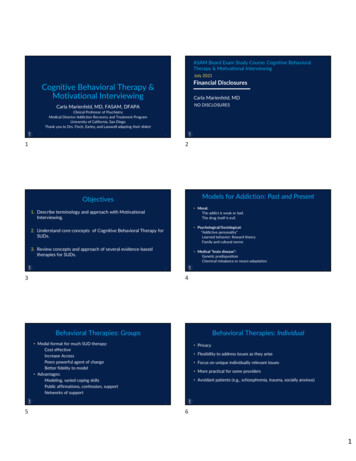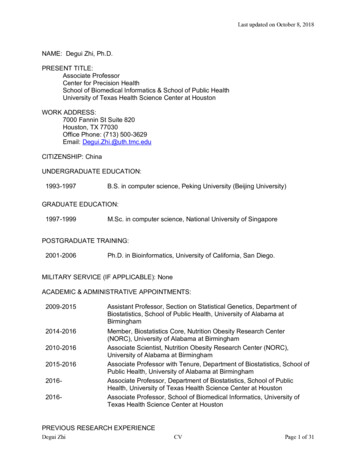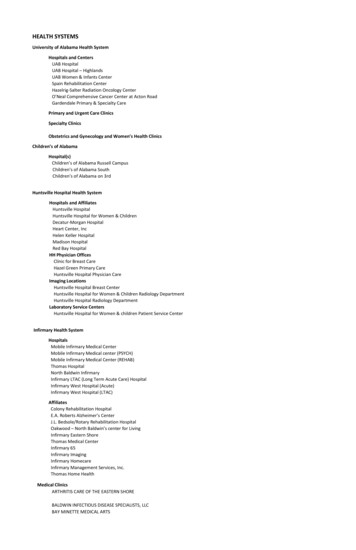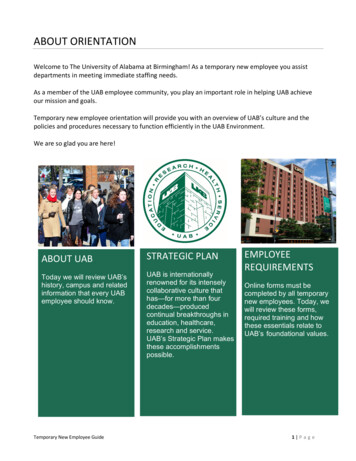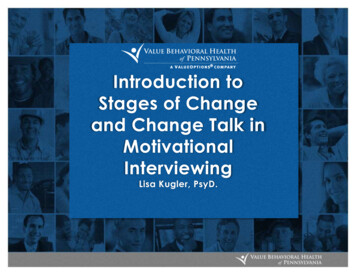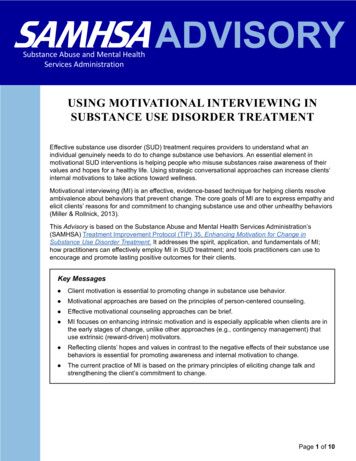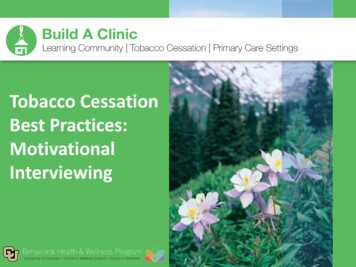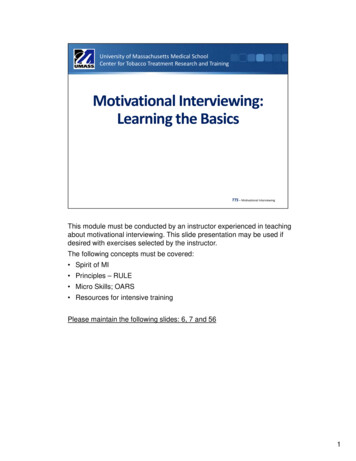
Transcription
TAILORED MOTIVATIONALINTERVIEWINGAn ImplementationToolkit
AcknowledgementsWritten by:Sylvie Naar, PhDEdited by:Sean Cahill, PhD, Hilary Goldhammer, MS, Linda Marc, ScD, MPH, AlexKeuroghlian, MD, MPHGraphic design by:Lisa Bryson and Rachel Kohn, John Snow, IncorporatedAdapted from: Naar S. Peer Motivational Interviewing (PEERS MI): AnImplementation Toolkit. Rockville, MD: U.S. Department of Health and HumanServices, Health Resources and Services Administration, HIV/AIDS Bureau, 2018.Funded by the University of Alabama at Birmingham Sparkman Center for GlobalHealth, the Caribbean Vulnerable Communities Coalition, and Florida StateUniversity Center for Translational Behavioral ResearchLead Trainer: Maurice Bulls, M.Ed.Behavioral Change 13-269-6721www.behaviorchangeconsulting.orgFor more information contact Melanie Gingrich 02
Table of ContentsOverviewPurpose1Goal1Target 3Initial TMI Training WorkshopModule 1: Introduction4Module 2: MI Spirit5Module 3: Managing Counter Change Talk and Discord7Module 4: Recognizing and Reinforcing Change Talk11Module 5: Eliciting Change Talk15Module 6: MI Process17Module 7: Implementation22Appendices24References36
OVERVIEWTailored Motivational Interviewing (TMI)PurposeThis toolkit provides an overview of Tailored Motivational Interviewing(TMI), Motivational Interviewing that has been tailored to target the HIVprevention and care cascades with special attention to youngpopulations. It contains tools, procedures, and materials to supportintervention delivery with high quality and fidelity. It also containsworksheets to be completed during workshop training.Goal To improve engagement and retention in HIV prevention andcare, as well as adherence to antiretroviral medications fortreatment and prevention To address other health behaviors for which self-managementis relevant, such as substance use and sexual activityTarget Population People living with HIV (PLWH). The intervention has beenparticularly successful with young people of color in theUnited States and globallyDescriptionTMI is an evidence-informed intervention comprised of brief single sessions ledby peer-level staff to encourage engagement and retention in care for PLWH atthe time of initial linkage or at re-entry into care. Medication adherence andother target behaviors relevant to self-management may also be addressed.The intervention is based on Motivational Interviewing (MI), “a son’sownmotivation andcommitment to change”.1,2 MI conversational style may also be thought of asguiding a person to change, rather than directing them to follow changeBCC MI TOOLKIT 1
OVERVIEWTo implement TMI with fidelity, relevant staff must receive: An initial training workshop delivered by a TMI trainer who is a member of theMotivational Interviewing Network of Trainers (MINT) A minimum of 6 individual coaching sessions by phone over 3 months Ongoing fidelity monitoring using recorded interactions or simulated clients usingthe Coach Rating Scale (see Appendix A) or demonstrate expert competencyon the Motivational Interviewing Treatment Integrity scale Regular booster trainings based on fidelity scores (at least annually)Note: A local coach or facilitator may be trained by a TMI trainer to providingongoing coaching, fidelity monitoring, and booster trainingsBackgroundMI arose from a blend of science and practice. The developersidentified strategies that worked in the addictions field, and thendeveloped a theory to support its mechanisms.1,2Thistheoryemphasizes a relational component that is focused on empathy andthe interpersonal spirit of MI, and a technical component that focuses oneliciting and reinforcing client “change talk.” MI is also consistent withseveral theoretical models including: Transtheoretical Model,3 which describes a series of 5 stages ofbehavior change that can result in long-term maintenance ofbehavior, and Self-determination Theory,4 which emphasizes that peopledevelop intrinsic motivation when they feel connected tothose who are kind and caring instead of those who are harshand controlling, when they feel hopeful and confident, andwhen they believe autonomy is supported.BCC MI TOOLKIT 2
OVERVIEWTMI is tailored to target behaviors relevant to the HIV prevention andcare cascades based on ongoing research and training experience,and has been tested across the HIV cascade for youth, one of the groupsat highest risk for poor outcomes.5-9 TMI is currently being evaluated in alarge-scale implementation trial with peers and other providers in 10adolescent HIV clinics in the United States.DurationTMI can vary from a single brief encounter to multiple sessionsbased on client need and organizational context. Sessions inhome-based or office settings can last 45 minutes to an hour,while sessions in medical clinics or street-outreach contexts maytake 15 minutes or less.Setting Community-based organizations or AIDS Service Organizations that have wellestablished linkage and referral systems to HIV primary care and provideongoing services to PLWH, or Primary care medical facilities that employ peers for service provision. Sessions range from a single brief encounter to multiple encounters Sessions can be delivered at a client’s home, office, the medical clinic, or in apublic space (street outreach).BCC MI TOOLKIT 3
TMI WORKSHOPINITIAL TMI TRAINING WORKSHOPThe TMI initial workshop consists of 7 Modules Introduction MI Spirit Managing Counter Change Talk and Discord Recognizing and Reinforcing Change Talk Eliciting Change Talk MI Processes Implementation.A single trainer may deliver the workshop to a group of up to 20participants. For every additional 20 participants, one assistant is required inorder to ensure the most beneficial learning environment.The workshop occurs over 2 days.BCC MI TOOLKIT 4
MODULE 1IntroductionFour TMI Skills1.Emphasizing Autonomy with YOU statements2.Providing Information in an MI Style3.Reflections for Change Talk4.Open Questions to Elicit Change TalkBCC MI TOOLKIT 5
MODULE 2MI SpiritSpiritOne WayAnother onHow Can MI Spirit Reduce Stigma?BCC MI TOOLKIT 6
MODULE 3Managing Counter Change Talk and DiscordSkill 1: Emphasizing Autonomy with YOU statementsEmphasize Personal ChoiceExample: “Yes, you’re right. No one can force you to take medications.”Example: “If you are not ready to talk about, we can focus on somethingelse.” Example: “It is your decision.”Your Example:Your Example:Promote Personal Responsibility with Positive “You” StatementsExample: “You really want to take ownership of your health.” Example: “You seethis as a challenge to overcome.”Example: “You want your first step to be.”Your Example:Your Example:Clarify Your Role as a GuideExample: “I am here to find out what is going on in your life and support you ifthere are changes that you want to make.”Example: “I’d like to find out what you want to do next rather than me tellingyou what to do.”Example: “I am not here to tell you what to do, but to see how I can support you.”Your Example:Your Example:BCC MI TOOLKIT 7
MODULE 3Skill 2: Providing Information in an MI StyleAsk-Tell-Ask/ATAASK options (reflect responses) To get permission/buy in To assess knowledge To assess interest or importanceExample: “Would it be OK if we talked about your test results?”Example: “What do you know about how the medications work?”Example: “Are you interested in finding out more about safer sex?”Your Example:Your Example:TELL (fill in the blanks; keep it brief: no more than a few sentences at atime!) Education Test results Recommendations Advice (with menu of options)Give information in a small chunk (a few sentences), then move to second ask,then another chunk of information (CHUNK-CHECK-CHUNK).BCC MI TOOLKIT 8
MODULE 3ASK options (elicit feedback; reflect responses) To assess understanding Reaction Determine next stepExample: “In your own words, what does this mean to you?”Example: “Is this new information or something you already know?”Example: “What might be your next step?”Your Example:Your Example:It’s Up to You: Supporting Autonomy StrategiesSTRATEGYCOUNT1) Emphasize choice (YOU)2) Emphasize personal responsibility (YOU)3) Clarify role as a guide4) Ask permission/client’s view (first Ask)5) Small chunks/menu of options (Tell)6) Elicit feedback (second Ask)BCC MI TOOLKIT 9
MODULE 3Managing Counter Change Talk and Discord with Stop-Drop-RollLevel 1: Small Fire - Counter change talk, passive, chatty, and little to nofollow-upLevel 2: Full Blaze – DiscordSTOP whatever you are talking aboutDROP to calm the situation down Express empathy/describe (reflect) feeling Affirm values and strengths Example: “You’re feeling frustrated, but you’re thinking aheadtoo.” (Describe feelings, affirm a strength) If full blaze – apologizeExample: “I am sorry it feels like we are harassing you.”ROLL by supporting autonomyExample: “You have a lot to manage and your job is yourpriority. The next step is really your decision.” (Emphasizingpersonal responsibility and personal choice.)If full blaze – shift focusExample: “You know yourself best. If you’re willing, I’d like tounderstand more about what’s going on in your life.”(Emphasizing personal choice, shift focus.)BCC MI TOOLKIT 10
MODULE 4Recognizing and Reinforcing Change TalkDARN CDesire: “I want to ”Ability: “I can ”Reason: “Because ”Need: “I need to ”Commitment (or steps): “I will ” “Idid ”I don’t like taking medications, but I want to be healthier.I tried to follow-up on that information you gave me, but honestly, alot of it didn’t make sense to me.I need to talk to my partner about using condoms, but I’m worriedabout the reaction I’ll get.Be careful: reflections of counter change talk lead to more counter change talk. I know I’m healthierwhen I take mymedication everyday, but sometimes Ijust don’t want tothink about it. You used to takethem every day. BCC MI TOOLKIT 11
MODULE 4Skill 3: Reflections to Reinforce Change TalkSIMPLE: A repetition or slight rewording of what the client said (stabilizes theconversation)COMPLEX: Deeper meaning (moves the conversation forward)OTHER: Double-sided: Reflect ambivalence and change talk Feeling: Reflect positive feelings about change, or negative feelings aboutnot changing Affirming: Reflect strengths, valuesExample: “I hate taking the medications, but I’m gonna have to do it every day. I know what Ineed to do.”Simple (stabilizing, connecting) Repeating: “You know what you need to do.” Paraphrasing: “They’re going to be an everyday thing for you.”Complex (moving forward, adding meaning) Deeper Meaning: “You want to take care of your health your way.” Double-sided: “On one hand, it’s hard to do something you don’t like doing;Otheron the other hand, you’re going to take care of yourself.” Feeling: “You feel good about taking care of yourself.” Affirming: “You already have some ideas about what you’re going to do.”Tips for Reflections Change it up; do not use all paraphrases; but use what feels natural Eliminate the stems – sounds like Avoid inflection that turns reflections into questions Respond to a question with a reflection End in the direction of change Stems for affirming reflections (use affirming reflections liberally): “It’s great that you.” “You’ve been working on change effort and it shows.” “With your knowledge, experience, or skill , you have a lot to build on.”BCC MI TOOLKIT 12
MODULE 4Reflecting Change Talk PracticeExample: “I know it might not be good for me, but I have to do this work to survive.”Simple:Complex (deeper meaning):Other (double-sided, feeling, affirming):1. “I need to keep going to clinic appointments, but I always feel like they are judgingme.”Simple:Complex (deeper meaning):Other (double-sided, feeling, affirming):2. “The doctor says the medicine will help me, but I really don’t like pills.”Simple:Complex (deeper meaning):Other (double-sided, feeling, affirming):3. “I have to talk to my family about my HIV status, but I’m scared. I’m not sure Ican do it.”Simple:Complex (deeper meaning):Other (double-sided, feeling, affirming):Summarizing ReflectionsSummaries are essentially reflections that pull together several things (at least 3points) that a person has told you. They: Draw together key client statements from the discussion Give client an opportunity to add or correct information Provide a foundation for moving forwardClinical Summary vs. MI Summary: Clinical summaries focus on topics and actions, including yours MI summaries focus on client statements (3 points from client)BCC MI TOOLKIT 13
MODULE 4Tips for Using Summarizing ReflectionsSummaries are especially useful when: You need to think more about the direction in which the session is going The client is very talkative You need to check for understanding It’s time to transition to another topic (see Appendix C below)Summary Starters and EndersStarters: “Let me see if I understand what you’ve told me so far ” “Let’s summarize what we’ve talked about so far.”Enders: “What have I missed?” “What do you want your next step to be?”Example: “Let me pause and summarize what we’ve just talked about.” “You’re not sure you want to be here and you only came because your mothermade you come. At the same time, you are concerned about your health. Yousaid you want to feel better, you need to take your medication more often, andyou want to avoid being admitted to the hospital. What did I miss? I’mwondering what you want to do?BCC MI TOOLKIT 14
MODULE 5Eliciting Change TalkSkill 4: Open Questions to Elicit Change TalkOpen questions and eliciting change talk serve 2 purposes:1. To ask for elaboration of change talk2. To elicit change talk when not occurring spontaneouslyOpen-Ended StartersOpen“To what extent vs.Closed“Did You How often Will You Why Can You Tell me about Is it ”Help me understand What, if any When, if ever How, if at all What else ”Instead of: “Are you concerned about ?”Try: “What concerns do you have about ?”Instead of: “Is important to you?”Try: “Why is important to you?”BCC MI TOOLKIT 15
MODULE 5Eliciting Change TalkTo elicit Change Talk, ask about: Desire, Ability, Reasons, Needs,CommitmentTYPE OFCHANGEEVOKING QUESTIONTALKDesire“What would you like to work on? What do you hope to get out ofour time together? What do you want to be different in your life?What do you hope would be better in your life if you did?”Ability“What are some changes that you have made before? What aresome difficult things that you have done before? How confidentare you that you can do this?”Reasons“Why would you want to make this change? What are thebenefits of making this change? How important is it for you do this?What do you think will happen if things stay the way they are? Howhas this helpful before? Why?”Need“Why is this something you need to do? What is the best thingthat could happen if you made a change? What is the mostimportant reason for doing ?”Commitment “What is the first step you will take? What is one thing you can doin the next week? How committed are you to making this change?What steps have you already taken?”BCC MI TOOLKIT 16
MODULE 6MI ProcessesSee also: Appendix C, Your MI Toolbox!EngagingGoals of Engaging Establish rapport and MI spirit Understand client’s dilemma or struggle Why are they talking – need to understand the why to do it, beforeyou can move to the what to do Explore values and goals (lays the groundwork for the rest of theprocesses)Gathering Information While EngagingTraditional assessments Focus on information gathering High ratio of questions to reflections (checklist!) Reduces client autonomy and partnershipMI integration Focus on supporting autonomy with the client as the expert Conversation-based with 1:1 reflections-to-questions ratio Build motivation by reflecting change talkEngaging and Your ValuesChoose your top 5 values (see list or add your own): 1)2) 3) 4) 5How can these values interfere with engagement (stigma)?How can these values promote engagement (reduce stigma)?BCC MI TOOLKIT 17
MODULE lanceFreedomQualityBraveryFriendshipRespect for othersCare for ervice to ceOpennessWisdomFocusingGoals of Focusing Explore agenda – both client’s and provider’s Clarify direction – target behavior Determine most efficient use of time/effort (main interest) Target behaviors come from the client, from the setting, and from clinicalexperienceBCC MI TOOLKIT 18
MODULE 6Three possible focusing scenarios – clear focus, several options, vague focusHealthLEVEL 1: ExploreSymptomsMedsLEVEL 2: Fine tuneLEVEL 3: Get specific interms of a target behaviorFocusing FunnelYour HealthBCC MI TOOLKIT 19
MODULE 6EvokingGoals of Evoking Evoke intrinsic motivation Guide patients to talk themselves into change Evoke motivational language – change talkThree Steps for Evoking Change Talk1. Recognize it when you hear it2. Reinforce it (reflect/affirm, ask for more)3. Elicit it when you don’t hear itExample of the Importance/Confidence RulerStep 1: On a scale from 1 to 10, where 1 is not at all important/confident and 10 isextremely important (or confident), how important is it for you to (or, how confidentdo you feel about )?12345Not at all67Somewhat8910ExtremelyStep 2: Reflect ResponseStep 3: Why did you chooseand not a LOWER number?Step 4: Reflect ResponseStep 5: What would it take for you to get to a HIGHER number (or to stay at a 10)?Step 6: ReflectEvoking with Client Values Explore client’s values with a list or have them draw a picture that represents akey value Asks and reflect:1. What does the picture represent in terms of your values? PARAPHRASERESPOSNE2. If you don’t make a change, how would it interfere with that value?PARAPHRASE RESPONSE3. If you do make a change, how will that help you live out that value?PARAPHRASE RESPONSEBCC MI TOOLKIT 20
MODULE 6PlanningGoals of Planning Develop a plan for change Determine steps that are consistent with level of motivation(importance and confidence) Develop if/then (back-up) plans for potential barriers Provide information if necessary (Ask-Tell-Ask/ATA)Planning FunnelBCC MI TOOLKIT 21
MODULE 7ImplementationTIPS from Comprehensive Practice and Consultation:Cliet SessionOutlineNOTE: The following processes are to be used with clients during an MIsession.The processes do not have to occur in this order but may betailored based on the needs of the client.1. Engaging With the ClientDeliver opening statement describing the purpose of the session, highlightingclient choice about any changeUse open questions (see Appendix C: Toolbox) and reflections to buildrapport and reinforce change talkElicit and discuss client’s view on target behavior (engagement/retention incare, medication adherence)Provide information (Ask-Tell-Ask) and “Assess” in an MI style when neededSummarize discussionBCC MI TOOLKIT 22
MODULE 72. Focusing the ConversationDiscuss the focus for the rest of session (i.e., set an agenda) usingopen-ended focusing questions (see Toolbox)Summarize the discussion3. Evoking Change TalkUse open questions and strategies to elicit change talk (See Toolbox)Reinforce with reflectionsSummarize and ask key question to lead to planning (Example: Wheredo you want to go from here?)4. Planning For ChangeAsk for permission to discuss a plan for next stepsUse open-ended planning questions to elicit a plan, including “if-then”plans (see Toolbox)If client is not ready to change target behavior, then consider a planto return to talk to peerProvide a menu of options with Ask-Tell-Ask if necessaryContinue to reflect change talk and commitment language and listenfor the re- emergence of counter change talk or discordElicit commitment language and reinforce with reflectionsExpress hope and optimismProvide a final summary (where client started, where they ended, theirchange talk, an affirmation – not necessarily in that orderBCC MI TOOLKIT 23
APPENDICESBCC MI TOOLKIT 24
APPENDIX AMI Coach Rating Scale1. The counselor cultivates empathy and compassion withclient.12341234Notes:12344. The counselor works to elicit client’s ideas andmotivations for change.123412341234Notes:12348.8. The counselor reinforces strengths and positivebehavior change with affirmations/affirming reflections.123412341234Notes:123412. The counselor manages counter change talk/sustaintalk and discord.1234Notes:2. The counselor fosters collaboration with client.Notes:3. The counselor supports autonomy of client.Notes:5. The counselor balances the client’s agenda with focusingon the target behaviors.Notes:6. The counselor uses reflective listening skills.Notes:7. The counselor uses reflections strategically.Notes:9. The counselor uses summaries effectively.Notes:10. The counselor asks questions in an open-ended way.Notes:11. The counselor solicits feedback from client(s).Notes:BCC MI TOOLKIT 26
APPENDIX ATarget Behavior(s) of Session:Circle one of the four competency ratings:Beginner: 2.0Novice: 2.0 to 2.6Intermediate: 2.6 to 3.3Advanced: 3.3X your response for whether each process was present in the session:Engaging Yes Partial NoFocusing Yes Partial NoEvoking Yes Partial NoPlaning Yes Partial NoX for styles present in session:FollowingGuidingDirectingItem 1. The counselor cultivates empathy and compassion with clients. Global item Degree to which counselor: Understands or makes an effort to understand the client’s perspective andfeelings, and to convey that understanding to the client Demonstrates empathy with feelings reflections and exploring the client’sperspective Demonstrates compassion by using his/her understanding of the client’sperspective to prioritize the client’s best interests and well-being Sympathy statements (e.g., expressing pity or an “I’ve been there too”attitude”) do not count in the scoring for this item.BCC MI TOOLKIT 27
APPENDIX AItem 2. The counselor fosters collaboration with clients. Global item Degree to which counselor:Negotiates with clients and avoids an authoritarian stance (i.e., “dancing instead of wrestling”)Includes skills such as supporting autonomy, evocation, balancing the agenda, and Ask-Tell-Ask Actively “mines” for client input and incorporates client suggestions Uses appropriate language all of the time (not too difficult or expert)Item 3. The counselor supports the autonomy of clients. Degree to which counselor:Emphasizes client’s freedom of choice and conveys an understanding that the critical variables for change are within the client and cannot beimposed by othersActs as a facilitator of client choices, helping to guide the client while respecting them as the decision maker (i.e., actively tries to find choice) Uses “emphasizing autonomy” statements and strategiesItem 4. The counselor works to evoke client’s ideas and motivations forchange. Degree to which counselor: Conveys an understanding that motivation for change, and the ability tomove toward that change, reside mostly within the client Avoids rigidly providing education without Ask-Tell-Ask Consistently attempts to evoke client motivations (see evoking questions)and seeks elaboration with reflections and open question.BCC MI TOOLKIT 28
APPENDIX AItem 5. The counselor balances the client’s agenda with focusing on the targetbehaviors. Degree to which counselor: Maintains appropriate focus on a specific target behavior or concernsdirectly tied to it while still addressing the client’s concerns Adopts a guiding style (versus following or directing) Sets an agenda that is well-specified Does not miss opportunities to direct the client to the target behavior oragenda (though agenda may be modified to address urgent needs) Manages time well and transitions between therapeutic tasks smoothly Balances session between client and counselor needsItem 6. The counselor uses reflective listening. Frequency count item Goal is to deliver two reflections to every question Stacked questions (i.e., a series of questions in which the counselor does notwait for a response) count as one question.BCC MI TOOLKIT 29
APPENDIX AItem 7: The counselor uses reflections strategically. Degree of reflections of change talk, and of balance of simple to complexreflectionsCoding SchemeSimpleComplexReflections ReflectionsNo change talk reinforced12Change talk sometime reinforced (at least 1-2 times)23Change talk consistently reinforced (few missed opportunities)34Item 8. The counselor reinforces strengths and positive behavior change withaffirmations/ affirming reflections. Frequency count item Affirmations are specific and not general At least two high-quality affirmations per interactionItem 9. The counselor uses summaries effectively. Count of frequency of summaries that pull together points from three or moreprior client statements Goal is at least two high-quality summaries plus a final summary (where clientstarted, where client ended, change talk and affirmation)Item 10. The counselor asks questions in an open-ended and clear way. Ratio of open versus closed questions Goal is two open questions to one closed Multiple choice questions count as open Ask-Tell-Ask questions do not count as closedBCC MI TOOLKIT 30
APPENDIX AItem 11. The counselor solicits feedback from clients. Degree to which counselor: Asks clients for their response to information, recommendations, feedback,etc. Includes strategies such as open- or close-ended questions, menu ofoptions, or reflect-and-pause strategies to solicit feedback Solicits feedback between chunks of information when provided The client’s response is an indicator of the quality of the solicitation offeedbackItem 12. The counselor manages counter change talk (sustain talk) anddiscord. Degree to which counselor: Responds to discord and sustain talk (i.e., counter change talk) eitherreflectively or strategically Uses Stop, Drop and Roll If truly no sustain talk/counter change talk or discord (unusual but possible),then code a 4.BCC MI TOOLKIT 31
APPENDIX BCoaching Session OutlineAsk: “How have things been going with MI lately? How did things go with the goal(s) you setlast time?” (Reflect) 3 minutes.Elicit change talk about their own MI practice (e.g., “What have you been workingon, what are some reasons why you want to get better at MI?”) 2 minutes.Listen to the recording, if available, and remember to advise the trainee that you willlisten to approximately 20 minutes (if longer, use first 5 minutes, middle 10 minutes,and last 5 minutes).ORComplete roleplay and record approximately 20 minutes (give 5-minute warningafter 15 minutes); or for more advanced trainees, ask them for a difficult case andengage in roleplay: Name: Age: Gender Identity: Ethnicity: Sexual Orientation: Living Situation: Context: Target Behavior: Practitioner Objective:Complete coding with BCC Coaching tool during SP or playback of submittedrecording.BCC MI TOOLKIT 32
APPENDIX BReview select codes:ASK trainee’s view of SP/Recording, strengths and areas for improvement (reflect)TELL 1 or 2 of the strongest ratings, 1 or 2 areas for improvement (record itemnumbers) with Chunk/Check/Chunk.ASK for feedback and determine coaching focus (10 minutes)Choice 1 (Playback):Play back recording and coach during playback (20 minutes)Coaching Focus:Choice 2 (Activity):Provide coaching activity related to codingCoaching Focus:Summarize and Ask Key Question Regarding Goals/Plan:BCC MI TOOLKIT 33
APPENDIX CYour MI Tool Box!TIPS:Reflect answers before asking next questionReinforce change talkSummarize every few pointsUse Ask-Tell-Ask (ATA) if necessaryOpen questions for ENGAGING:Example: “What is most important to you right now?”Example: “What have you been up to since the last time we met?”Example: “What would you like to get out of this session today?”Your Example:Your Example:SUMMARIZE!Open questions that work for FOCUSING:Example: “Of all the different things you mentioned when it comes to {target behavior}, whatwould you find most the helpful to discuss first?”Example: “If it is ok with you, I want to discuss {target behavior}. Or, is something else more pressingto you at this moment?”Example: “If you were going to change one thing about {target behavior}, what would it be?”Your Example:Your Example:SUMMARIZE!BCC MI TOOLKIT 34
APPENDIX COpen questions that work for EVOKING:Example: “Of all the different things you mentioned when it comes to {target behavior}, whatwould you find the most helpful to discuss first?”Example: “What are some reasons for changing {target behavior}?”Example: “What would be the best thing that would happen to you if you changed {targetbehavior}?”Example: Use Importance and Confidence RulersYour Example:Your Example:SUMMARIZE!Open questions that work for PLANNING:Example: “What steps are you willing to take, in the next week, to reach your goal?”Example: “When and how will you start your plan?”Example: “What might get in the way of your plan and how will you handle it?”Your Example:Your Example:REMEMBER FINAL SUMMARY (using the person’s own statements, in any order):Where client startedWhere
Lead Trainer: Maurice Bulls, M.Ed. Behavioral Change Consulting . coachbulls@behaviorchangeconsulting.org 313-269-6721 . www.behaviorchangeconsulting.org . For more information contact Melanie Gingrich at . mgingrich@behaviorchangeconsulting.org. 530-588-1202
